Intel’s Discrete GPU Era Begins: Intel Launches Iris Xe MAX For Entry-Level Laptops
by Ryan Smith on October 31, 2020 12:01 PM ESTIntel’s Vision for Sharing Work: Deep Link & Additive Ai
As mentioned towards the start of this article, Intel is taking an interesting tack with Xe MAX. From a graphics standpoint, the company has not developed a multi-GPU solution to combine the rendering power of Xe MAX with Tiger Lake’s iGPU. As a result, Xe MAX is not significantly more powerful than Tiger Lake’s iGPU for 3D rendering/gaming tasks, greatly limiting the utility of Xe MAX for gaming purposes.
Although this wipes out the obvious route for using Xe MAX to augment Intel’s iGPU – and thus make Xe MAX a significant upgrade for graphics purposes – on the whole it’s a decision that makes sense for Intel. Multi-GPU graphics is hard, and it’s only getting harder. Even NVIDIA, with all of its experience in the field, has essentially pulled out as of their latest generation of hardware, thanks to rendering techniques getting less and less multi-GPU friendly. So what chance would Intel have, especially with such low-end hardware? Probably not much.
But that doesn’t mean that Xe MAX doesn’t have a purpose. Even if it can’t be used to help with any single task/thread, it can still handle additional tasks/threads, essentially having it function as a co-processor to offload tasks to or to spin up extra tasks on. This is a use case that professional-grade video cards and associated software have supported for a number of years, and it’s the same route Intel is taking with Xe MAX.
This kind of functionality is a core part of what Intel is terming its Deep Link technology, which is their umbrella name for all of the technologies backing and abilities sprouting from using Intel’s CPU and dGPU together. In practice, Deep Link is Intel’s software and firmware stack for Xe MAX, ranging from how they’re balancing TDP allocations between the CPU and GPU, out to how they present the additional processing blocks from an Xe MAX GPU to software so that it can easily use them. There is no real hardware magic here – as previously mentioned, Intel is using a standard PCIe 4.0 x4 link back to the CPU – but the company sees the synergy between their CPUs and Xe MAX as being a defining factor of the graphics solution – and why customers would want it.
Arguably the most critical part of Deep Link is what Intel is terming “Additive Ai”, which is the ability to use the iGPU and dGPU together within a program. As previously mentioned, Intel’s focus here is on enabling developers to use Xe MAX for additional workloads. Among other things, Intel’s examples have included using Xe MAX’s compute resources for batch processing images in Gigapixel AI, and using the chip’s video encode blocks to increase the number of video streams that can be simultaneously encoded.
This sort of batch-focused software is the ideal use case for Xe MAX. If a task can be broken down into multiple independent pieces, then it can easily be farmed out to both GPUs simultaneously – and thus justifying adding Xe MAX to the mix rather than just relying on Tiger Lake’s iGPU.
As for what software can use these capabilities, conceptually any software that can handle issuing work to multiple GPUs is in a good place. Even if it can’t handle Xe MAX out of the box, it should take very little work to get it seeing multiple Intel GPUs. Otherwise, this is where Intel’s control of the software stack should be an advantage, as it gives them opportunities to abstract certain parts of the multi-GPU equation from software developers. Though at the end of the day, that software still needs to be able to issue independent workloads to properly make use of Xe MAX.
The need for independent workloads and batch processing, in turn, is why Intel is focusing on what they term “mobile creation” workloads. These tasks aren’t typically processed in real-time, and broadly speaking have the greatest overlap with what the Xe MAX hardware can do. So although Xe MAX isn’t especially useful as stand-alone graphics adapter, Intel sees it as an excellent accelerator.
Overall, Intel is still in the early days of software support for Deep Link and Xe MAX. The company is working with software developers to get multi-GPU support added to more software down the line, so that more programs can take advantage of farming work out to Xe MAX. Along with getting more batch-style software enabled, the company is also working to enable Xe MAX to help with large, single-stream video encoding. Since video encoding is not hard-bound to being a serial task, Intel is looking at ways to split up a large encoding job so that each Xe encode block gets a chunk of the video to work on, a similar process to how multi-core CPU encoding works today. For now, Intel is targeting the first half of next year.
Sharing Power: Extending Adaptix to dGPUs
Along with sharing work, Deep Link also encompasses Intel’s technology for sharing/allocating power between their CPUs and Xe Max. Intel calls this Dynamic Power Share, and its an extension of their Adaptix power management technology, which the company has offered since Ice Lake.
Intel’s Adaptix is a suite of technologies that includes Dynamic Tuning 2.0, which implements DVFS feedback loops on top of supposedly AI-trained algorithms to help the system deliver power to the parts of the processor that need it most, such as CPU, GPU, interconnect, or accelerators. With Adaptix enabled, the idea is that the power can be more intelligently managed, giving a longer turbo profile, as well as a better all-core extended turbo where the chassis is capable.
Intel already uses Adaptix to allocate power between their CPU cores and iGPU, among other blocks, so extending it to include Xe MAX is a natural (and necessary) extension of the technology. According to Intel, the company has also learned a great deal from their previous dGPU-style effort, Kaby Lake-G and its on-chip AMD dGPU, which they have taken into account when extending Adaptix for Xe MAX.
Like Adaptix for CPUs, just how well this feature is used is going to be largely in OEM hands. Intel provides the tools, but it’s up to OEMs to set their various tuning values and plan for how that interacts with the power delivery and cooling capabilities of a laptop. But with Intel starting small on Xe MAX’s rollout – there are only 3 laptops shipping this year – hopefully it means Intel has been able to give the OEMs and the devices an appropriate level of attention.
Ultimately, Intel considers Adaptix/Dynamic Power Share to be another software-driven advantage for their gear. From a competitive standpoint the company believes that their tech does a better job of power management than how MX350-enabled laptops handle power allocations – particularly, that Xe MAX laptops don't have to permanently and continually reserve thermal and power headroom for the dGPU – and thus can unlock more performance even in CPU-limited workloads. That said, it's a bit of a dubious (or at least, non-intuitive) claim, as laptops have been able to shut off dGPUs for years now. But, as is often the case with power-saving features, how well any of this is tuned in shipping system is up to the OEMs – and Intel says that they've found that most systems in this class with (rival) dGPUs aren't allocating the CPU its full headroom.
A Word on Gaming Performance
Since Intel lacks a way to combine multiple GPUs for a single rendering/gaming task, the company is not really pushing Xe MAX as a gaming solution for obvious reasons. Nonetheless, on paper Xe MAX should be faster than Tiger Lake-U integrated graphics by around 20% thanks to the discrete adapter’s higher clockspeeds, so there are potential advantages to gaming on Xe MAX. So it’s something that Intel is making sure to support all the same.
The final pillar for Intel’s software stack, Xe MAX’s drivers include an arbiter of sorts to help direct games to use the correct GPU. The “correct” GPU in this case is often – but not always – the Xe MAX GPU. But in a surprising (and welcome) bit of transparency from Intel, the company admits that in some scenarios Tiger Lake’s iGPU may outperform Xe MAX, and as a result those games shouldn’t run on Xe MAX. So the arbiter’s job is to direct a game to use whatever Intel’s software has deemed the best choice for a given game, be it the iGPU or the dGPU.
This is another case where Intel will be providing a degree of abstraction, ideally hiding all of this from a game developer. Unless a game specifically goes ahead and implements support to detect and select from multiple GPUs, then Intel’s drivers should pick the right GPU for a game.
Functionally, all this sounds very close to how NVIDIA’s Optimus technology works, just with an added wrinkle of purposely sending some games to the iGPU rather than favoring the dGPU for all games. Now that Intel has mobile dGPUs they need a way to manage their use, and this is it. Plus Intel’s long-term plans of course call for more powerful Xe-HPG GPUs, so getting their GPU switching tech out and debugged now is going to benefit them in the long run.
As for performance expectations, with Xe MAX’s higher clockspeeds, Intel is promoting Xe MAX as being generally performance competitive with MX350. Mind you, Intel isn’t aiming to set a very high bar here, but Xe MAX should at least be good for 1080p gaming (most of the time).
Launch Laptops: Acer, ASUS, & Dell
Last but not least, let’s take a look at the first laptops that will be shipping with Xe MAX graphics. Intel is starting things off with a relatively small number of laptops, with Acer, ASUS, and Dell all set to release their Xe MAX-equipped notebooks in November. These are the Acer Swift 3X, the ASUS VivoBook TP470, and the Dell Inspiron 15 7000 2in1.
All three laptops generally fit the thin-and-light paradigm that Intel is pushing with Xe MAX. The Swift 3x is a 14-inch laptop at 3lbs, and the VivoBook Flip TP470 is 14-inches as well at a slightly heavier 3.3lbs. Finally, Dell’s Inspiron is a 15-inch convertible notebook that weighs around 4lbs. All of these notebooks come with high-end versions of Intel’s Tiger Lake-U SoCs using G7-class iGPUs.
At this point we’re still waiting for pricing info on the complete set of laptops. With this being a major Intel launch Intel is going to want to put their best foot forward – and will likely eat most of the marketing costs in the process – though at the same time the company is looking to sell Xe MAX-equipped laptops as premium notebooks, so there is a careful balance to be had.
Officially, Xe MAX is launching today. However it’s not immediately clear whether any of these laptops are actually going to be available right away, or if they’re going to show up later in the month. So it may be a couple of weeks until there’s actual retail availability. On which note, as far as regional distribution goes, the Acer laptop will be China-only, the ASUS laptop will be sold in both China and North America, while the Dell will be North America-only (sold via Best Buy).
Overall, the launch of Intel’s Xe MAX graphics and the DG1 GPU is an important day for Intel, but this is also a launch that strikes me as Intel having modest expectations. Xe MAX is only being launched in a small number of laptops for now, and Intel is not seriously chasing the gaming market with their first discrete laptop part. None the less, it will be interesting to see what kind of traction Intel can get as a new player in the market, especially with their focus on mobile creation and selling Xe MAX as an accelerator for productivity and content creation tasks. No matter what, Xe MAX will be something that bears keeping an eye on.


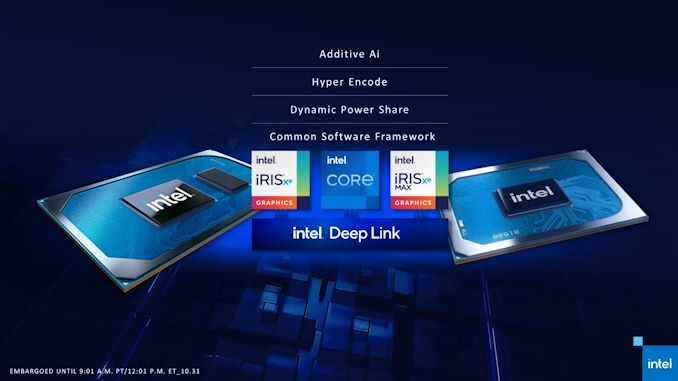
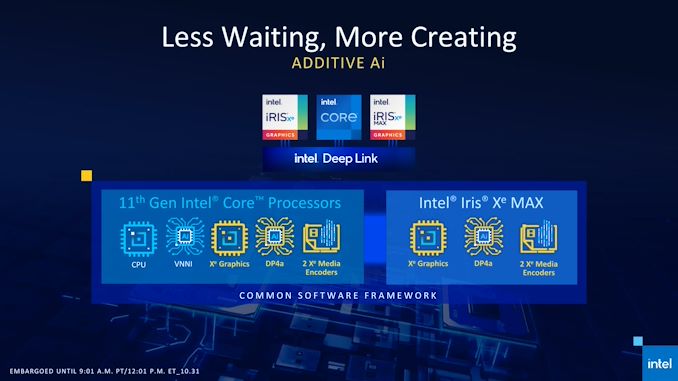

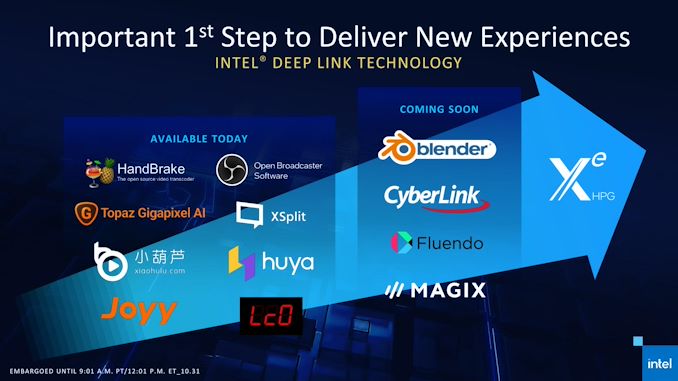
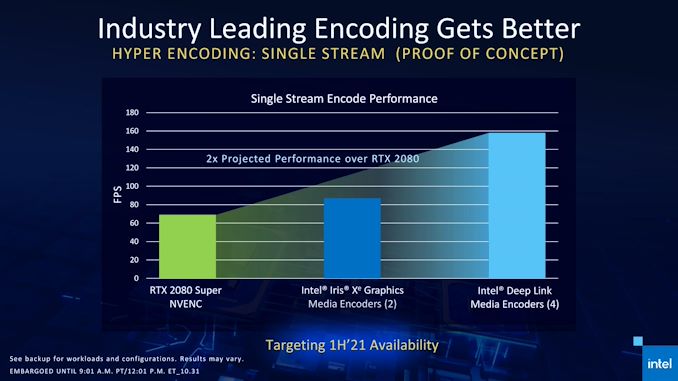

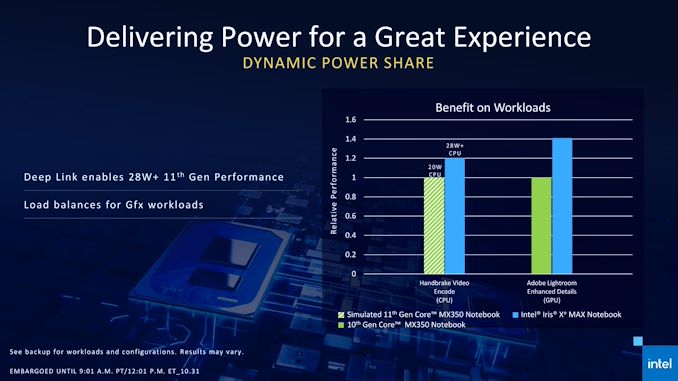
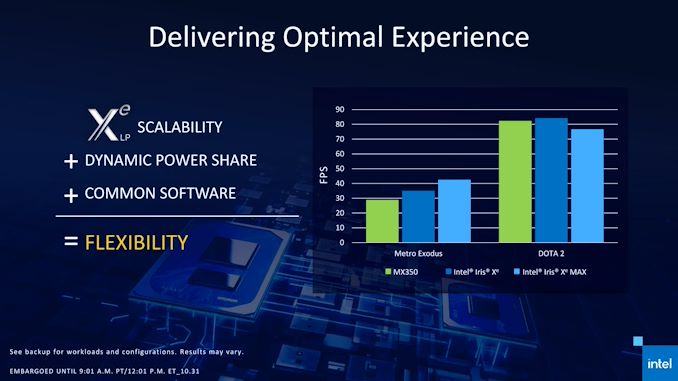
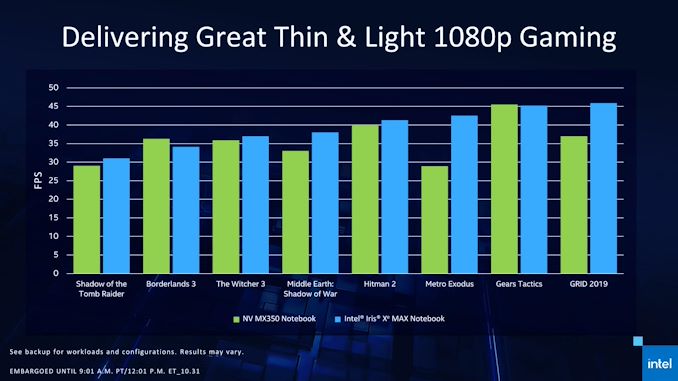
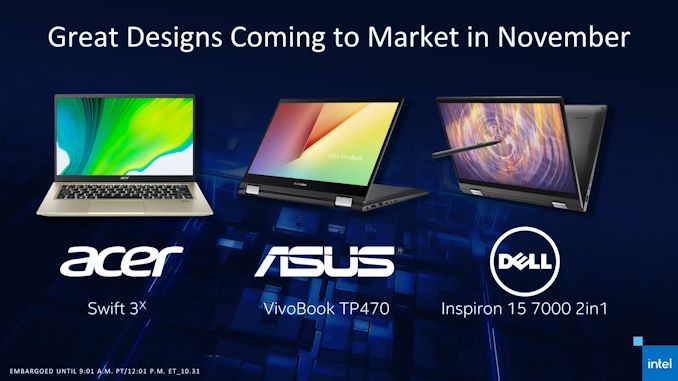



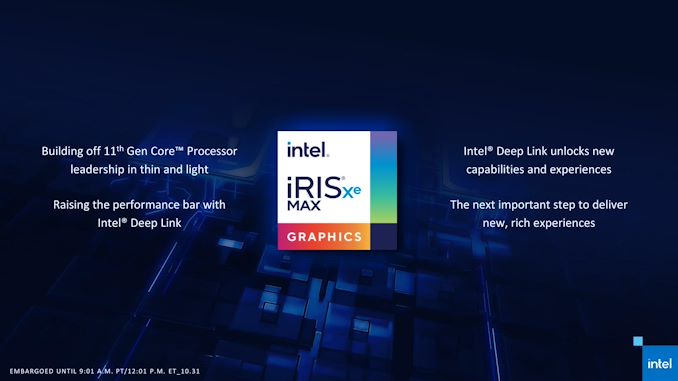














118 Comments
View All Comments
Spunjji - Sunday, November 1, 2020 - link
I'm not saying they aren't. I was talking about how they keep pitching products that they talk up, launch, then mysteriously go quiet on.Then boom, another launch, quickly talk about this one and forget the last one!
I don't buy this "they don't have experience making a PCIe card" thing. Aside from this not actually being a PCIe card, per se, they do already have lots of experience both with building actual cards and connecting accelerators over PCIe. You just admitted it, and then fumbled on why it's not relevant.
SolarBear28 - Sunday, November 1, 2020 - link
Many of those other technologies at least showed promise in the first generation. This is just a duplicate iGPU that cannot used in tandem with the existing iGPU in 90% of workloads.throAU - Monday, November 2, 2020 - link
Thing is, this isn't their first iteration of a GPU. They've been doing integrated graphics for 2+ decades at this point and they had a crack at discrete cards back in the 90s.It isn't even their first discrete GPU in a while. They literally just chopped the thing out of an integrated part and stuck it on a card. Sorry, but that's garbage. Unless they stick a real GPU memory controller on it with a decent amount of bandwidth and significantly increate the EU count .... it is entirely pointless.
JustMe21 - Saturday, October 31, 2020 - link
This is one of the instances where it demonstrates how Intel can bring itself back up to par with AMD because AMD has had opportunities to do the same thing, but just kept rehashing Vega in their APUs. Now that AMD is on par with Intel in single core IPC, they need to work on the extra features of their CPUs and GPUs.ballsystemlord - Saturday, October 31, 2020 - link
Navi 1 is also based on Vega. Does that make it a "rehash"?JustMe21 - Saturday, October 31, 2020 - link
Well, Cezanne could have been Navi, but it's using Vega yet again. It would have been interesting to see an RDNA2 based APU and discreet RDNA be able to function like a big.LITTLE Navi, especially considering RDNA2 introduced Smart Access Memory.fmcjw - Saturday, October 31, 2020 - link
A good followup discussion would be the state of drivers and software support among the 3 dGPU camps. It seems at the entry level we have hardware parity now.KaarlisK - Sunday, November 1, 2020 - link
Yup. Because Intel has the horrible policy of dropping drivers of current-2 generation from the current branch and moving them to legacy. Broadwell, once touted as "you can finally game on it", is already on bugfix support only. It seems they will even be dropping Skylake, simply because it is too old, even if it is almost the same as the still supported Kaby lake.Spunjji - Sunday, November 1, 2020 - link
Yup, and Intel's drivers are miserable from a gaming perspective. Several of the games they quote frame rates for have known bugs on their hardware.Spunjji - Monday, November 2, 2020 - link
"Cezanne could have been Navi"Could it, though? Maybe RDNA; probably not RDNA 2 based on the time-frames involved, though. Given the performance they get from Vega already - and how absolutely tiny it is - I can see why they didn't go for the interim design that appeared to be fairly inefficient in terms of transistors vs. performance.